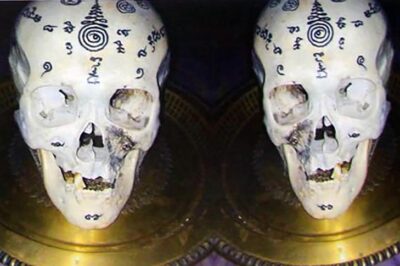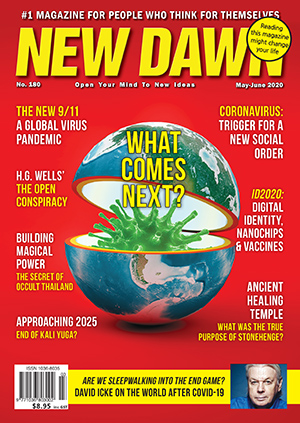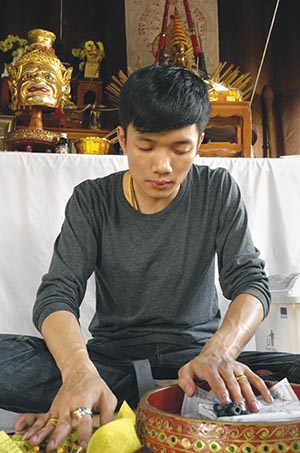From New Dawn 180 (May-June 2020)
The Thais call it Samathi, the crucial element when constructing magical items or using magic to influence events and people. Pronounced sa-ma-tee, Samathi is sharply focused intention, and a major contributing factor in the efficiency of all forms of magic as it facilitates access to various sources of power.
Samathi is acquired and enhanced through dedicated practice and rigorous training using some or all of the techniques discussed in this article. In some individuals, it manifests innately.
A controlled, highly focused but calm mind can access further magical power by harnessing a spirit – such as a stillborn child or person who died a violent death. These spirits then act as a spirit familiar to aid magical tasks. One branch of Thai magic trains practitioners to directly manipulate the intimate products of a target person, such as sperm, hair, fingernails and even clothing – to harm, bind in love, bring good fortune, or remove spirit attachments. Additionally, Samathi aids magic with the utterance of spells and kata (mantra). In general, there is a combination of some, if not all, of these elements. But Samathi is essential for each of these available sources of power.
The practices within Buddhism in the pursuit of enlightenment in this lifetime can also bestow various magical abilities. Many of the Buddha’s disciples attained these powers even though the Buddha himself rejected the practice of magic as a distraction.
- Telepathy – the ability to know the thoughts of others.
- Clairaudience – the ability to hear across long distances.
- Clairvoyance – the ability to see the imperceptible.
- Astral Travel – the ability to travel to celestial realms.
- Telekinesis – the ability to move items from a distance.
There are accounts of these abilities manifesting to varying degrees in most of the famous Thai monks and Ajarns (lay practitioners). The powers are perceived both as a boon to their followers and evidence of a heightened state of being. Possessing such magic is also seen as a measure of a person’s dedication to their studies and their moral goodness. Many monks and Ajarns exemplify the quality of Metta (loving-kindness), which in turn attracts more devotees. There are Ajarns considered to be an old magician on their latest cycle of life; they bring with them enhanced abilities and an uncanny speed of learning. Many Ajarns come from a familial lineage of sorcerers dedicated to following the magical path, committing themselves to the study of occult magic that requires the use of numerous written scripts, the ability to perceive the supernatural, and an encyclopaedic knowledge of spells, rituals, plants, woods and kata.
The system of magic in Thailand intertwines with knowledge accumulated by an ancient culture. It is considered one of the few complete systems in the world today, and a system that absorbed numerous influences over the centuries. At its core, it is pure Animism, with the magician working with supernatural products, spirits and ghosts.
The supernatural products come from both nature and the remains of people who died in what is known as a ‘Prai Death’ which grants their body products magical potency. These types of death are related to dying before one’s time through violence, accident, suicide or killed by nature. This system existed before the introduction of Buddhism, but without the influence of that great philosophy, it would appear to be akin to Haitian Vodou and some of the traditional African practices. The influx of Buddhism brought control to magic through its associated practices, acting as a refuge when needing protection from some of the violent supernatural forces existing within the Thai Occult. Buddhism also brought mantras (kata) and the written language, which helped preserve the knowledge and practices of the magical path.
It is not the purpose of this article to outline meditation techniques as there are many teachers for that. Instead, here are some of the techniques used by the Thai people who choose a spiritual path to build their Samathi to extraordinary levels.
Tudong – A ‘shaking off’ of mental defilement, derived from a Pali word meaning ‘ascetic practices’

– Ajarn Suea, Chiang Mai, Thailand
Buddhism flourished in Asia by accommodating the native beliefs of the cultures with which it came into contact. Regional differences within Thailand resulted in a vast number of sects, with eighteen in Chiang Mai alone. A process of reform was undertaken that resulted in the Tammayut sect which drew heavily from the strict discipline of a Burmese monastery. The aim was one Buddhism within the country that overrode local traditions. One of the features of the Tammayut sect is the tradition of wandering in the wilds, where hardship leads to self-knowledge – the first great monk to practice this was the legendary Ajarn Man.
Until relatively recently, Thailand was a wild place. Dangerous animals ruled the wilderness, roads were few, and the fear of ghosts and spirits was intense. In Buddhism, fear is considered a defilement that needs rooting out. Perilous places acted as a training ground for the monks of the Tammayut sect, the aim being spiritual liberation. Samathi is an important component of this process as the mind’s energies are focused for great strength and the ability to uproot attachments, cleansing it so that it is bright and clear.
These monks often stayed in cemeteries, but in those times, unlike today, there were rotting and relatively fresh unburied bodies everywhere. The monks would have encounters with ghosts and local spirits. Experienced monks sought these places to practice meditation undisturbed. For monks who were afraid of ghosts, the experience was transformative. The dead were carried to the grounds on a bamboo platform. To overcome fear, monks on Tudong – ‘shaking off’ mental defilement – often chose these platforms to rest for the night. During such trials, monks confronted these fears in the process of uprooting the cause, understanding death and the realms of ghosts and spirits. These monks were tough and resilient with a magical potency that we can only hanker for in the modern world.

Through his training, Ajarn Man possessed the ability to communicate directly with beings from different realms of existence. He was said to be in continual contact with beings from the higher and lower celestial realms, the spirits of the terrestrial realms, ghosts of many sorts, and even the denizens of hell through his inner psychic faculties. Ajarn Man’s training included a period where he used the image of a bloated, seeping corpse. He contemplated it at all times until it changed into a translucent disc that appeared suspended before him. As he focused on the disc, it continued to change, and he followed these changes for three months. It was a seemingly endless series of developing images, permanently in flux. Ajarn Man eventually realised that he was not attaining the beneficial results of calmness and peace which would have convinced him this was the correct method to attain an iron Samathi – so he changed it. Instead of travelling with the mind, he focused internally, on his own body, to investigate every part, and bring everything within. It worked.
Ajarn Man possessed a mastery of psychic skills. Over the years, his proficiency grew to the point where the monks living with him took great care to be mentally self-controlled at all times. They couldn’t let their minds wander lest their wanderings became the subject of a Dharma talk that evening, and they had to hold extreme focus when meeting him because he made an issue of any stray thoughts. It became the subject of much joy for his disciples, always waiting to hear who got caught.
Students of Ajarn Man continued his teachings after he passed away, giving rise to such remarkable monks as Luang Phor Pina, and what is termed the great generation of magical Thai monks, almost all of whom have now passed away.
Although the tradition of wandering meditator ascetics eventually fell victim to Thailand’s relentless modernisation and rampant deforestation, Tudong is still undertaken in the more remote parts of the country. A period for Tudong continues to be part of training for some monks, Ajarns and Lersi (seers) who observe the thirteen ascetic practices mentioned in the Buddha’s discourses. These include eating only one meal per day, sleeping outdoors in a forest or cemetery, and being content with the fewest possessions. The ascetic life tests their skills and offers the chance to hone the piercing focus that comes with such practices. All this can then be put to use in any aspect of the Thai Occult.
The 32 Parts of the Body Meditation
A significant form of meditation undertaken in Thailand is the exploration of the “32 parts” of the body for building Samathi and an understanding of impermanence. As with many techniques discussed here, this form of meditation also has an occult usage. This practice aids in the knowledge of the true nature of the body, eventually bringing a comprehension that the body consists of the four elements earth, water, air and fire. The idea is for the devotee to use their Samathi to discover their own body, every single component of it. The practice also aids the understanding that there is no self – there is just a body with all its frailties. The levels of sensitivity attained through this system can be astonishing. As the meditation develops, some parts of the body begin to break down, in the practitioner’s mind, into the primary elements of solidity, liquidity, motion and temperature, expressing the link between this and the use of the four elements in Thai Occult practices.
The Thai Ajarns, through their knowledge and understanding of the 32 parts, worked out a way to construct a spirit akin to reversing engineering from their study of the body parts in themselves. This is the first thing studied in the process of making talismans. The 32 parts of a body can be divided into sections depending on the associated element. The four elements in Thai are Na Ma Pa Ta or earth, water, wind and fire stated in the Western way. This knowledge and practice applies when making amulets, combining the four elements with the 32 parts of the body to create a spirit that works for the benefit of the devotee. Some Ajarns even give the spirit an outward image.
A combination of the four elements creates everything. A human being consists of these four elements – breath is the wind, blood is the water and flesh is the earth, etc. Na is the earth element, Ma is the water element, Pa is the wind element, and Ta is fire. When combining these, elemental Kata can be used to assist in raising the power of an amulet. The water element is used for Metta because water is the coolness, the ease, the comfort. If an Ajarn wants to add attraction, the wind element is needed to help pass the power to the person and carry the message of attraction. The earth element is vital for invincibility magic. Combining the earth and water element helps with protection, i.e., if fire was the danger, water puts it out. If a person needs protection from black magic, the fire element is used to burn away dangerous forces.
Kata (mantras) are an integral part of the processes mentioned above and carry a power of their own. They are normally assembled from Buddhist passages, although some kata are older than Buddhism and others are condensed forms of magic for a specific purpose. All deities, spirits and Buddhist entities have kata associated with them, and each act as the key to bringing out their assigned magic. Kata are also associated with the actual properties of Thai magic, be it for charm and attraction, good fortune or authority. The practice and understanding of kata is another of the core elements undertaken by the magician, to eventually become the magic itself, to embody kata, which is why entering the monkhood for a period of time is highly valued by the members of the Thai Occult community. Being a monk is the best practice to rise above the mundane and to raise Samathi because it powers every other practice.
The final element of this discussion on available sources of power in Thai magic is the power of lineage. Most Thai magicians come from lineages, long lines of astute occultists who embodied their form of magical knowledge known as Wicha. No one knows the extent of the Wicha of Thailand (and yes, it comes from the same root word for Wicca). These lineages hold great power, and the living magician can call on this power to help with any work he is undertaking. Some occultists in these lineages are incredibly powerful, and there are instances where they cannot be named, else they ‘come’. The magic available from this source cannot be underestimated.
Peter Jenx is the author of a series of books on Thailand’s occult/magical practices. The Thai Occult 2 – Regions of Power is available here. The Thai Occult Appendix, is available from Timeless Editions of France (limited to 399 copies) at www.timeless-shop.com/product/appendix-jenx/. A previous edition is available in PDF from www.thethaioccult.com. Through the website you can also obtain a range of Thai-produced occult items including amulets.
© New Dawn Magazine and the respective author.
For our reproduction notice, click here.




